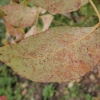How to recognise it
In spring bright orange pustules appear on the leafstalks, branches, leaf underside and any remaining hips. During summer yellow-orange pustules then develop on the undersides of leaves, becoming interspersed with black pustules in late summer/early autumn.
Why it’s a problem
As well as being unsightly, the rust fungus feeds off the plant’s own supplies thereby weakening the plant.
The fungus has multiple stages in its lifecycle, each one producing different spores. The original orange pustules produce aeciospores, which infect leaves and in turn produce the yellow-orange pustules. These contain urediniospores which germinate to form black pustules, containing teliospores which then overwinter on fallen leaves, to germinate in the spring producing basidiospores which are blown by wind, or splashed by rain, back onto the host and other plants, thereby increasing the spread of the infection each year. The teliospores can also survive in the soil or on stems.
Where you are likely to find it
Most modern rose cultivars have a level of resistance to rust, but older varieties can be more susceptible.
How to prevent it
A wide range of roses are available with some resistance to rose rust and advise should be sought when purchasing.
Ensure good plant hygiene, particularly collecting and destroying fallen leaves on which the disease can overwinter.
How to get rid of it
Remove and destroy fallen leaves.
Use of a fungicide such as mancozeb, myclobutanil, penconazole or triticonazole can also be effective.
Is it good for anything?!
No.
Other useful information
This is less severe than rose black spot and powdery mildew, which are the other two most common rose diseases.





